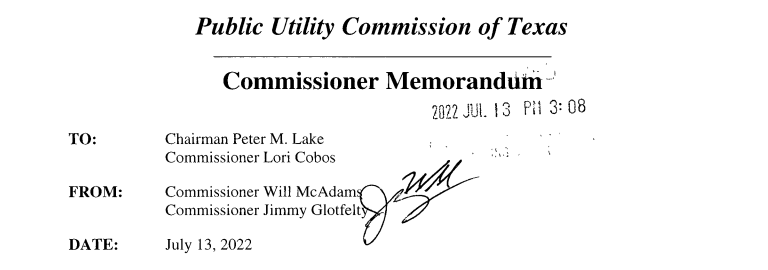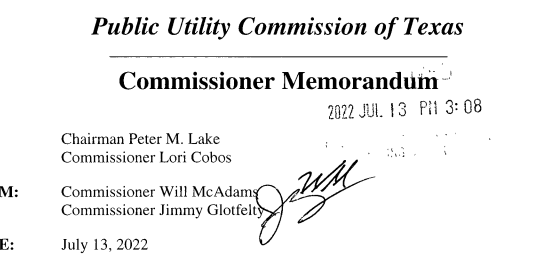A few days ago, the Texas Public Utility Commission (PUC) said that it was creating a memo to address issues that Commissioner McAdams touched upon in the July 11 workshop. To recap, Tesla Energy has been working with the PUC and the Electric Reliability Council of Texas (ERCOT).
The focus is on educating the utility and the commission about the benefits of allowing Tesla Powerwall customers in Texas to participate in virtual power plants (VPPs).
Tesla’s U.S. Energy Markets Policy Lead, Arushi Sharma Frank has been present at every meeting and has been working diligently to advocate for clean energy and Tesla Energy’s Texas customers.
The Memo
The previously mentioned future memo addresses some of the issues that Commissioner McAdams brought up in the July 11 workshop. He and Commissioner Glotfelty co-authored the memo.
The memo reads as follows:
As discussed during the June 16, 2022, Open Meeting and July 11, 2022, Aggregated Distributed Energy Resources (DER) Pilot Workshop, we support efforts to create a pilot project to test impacts of small-scale DER aggregation in the ERCOT market.
The pilot will answer questions related to how aggregated distributed generation can support reliability, enhance the wholesale market, incentivize investment, potentially reduce transmission and distribution investments, and support better load management during emergencies.
In the short term, we expect the pilot will bring in vital megawatts (MWs) of resources for participation in the ERCOT market.
ERCOT staff are required to prepare and present a governing document detailing the project scope to ERCOT’s board of directors.
The PUC will form a Task Force to identify operational obstacles to launching a pilot program and to assist ERCOT in drafting the governing document.
The next meeting to discuss the purpose and structure of the Task Force will be held on July 28, 2022. The governing document should be presented to the ERCOT board by October 11, 2022, so that it can meet a desired pilot start in the first quarter of 2023.
The Guiding Principles
The memo included five guiding principles that the commissioners want the pilot project to consider. They are:
- Understand the impact of having ancillary services carried on the distribution system.
- Create a structure that incentivizes competition and attracts broad DER participation through load-serving entities (LSEs).
- Measure the impacts of relieving or causing congestion on the distribution system, and study how to transition distribution-level aggregations to more granular dispatch and settlement.
- Ensure adequate customer protection is in place and information is anonymized.
- Start simple while ensuring economies of scale exist on a MW [megawatt] basis to attract broad participation. The pilot parameters should have the flexibility to progress to more complex scenarios as participation increases.
Project Scope.
This next section of the memo addresses the governing document that shares the project scope with ERCOT’s board of directors. These topics are scale, duration, transmission and distribution utilities participation, interchange of customers, and reliability.
The following is from the memo detailing each topic:
- Scale – Aggregations should be constrained within a load zone, with a single LSE, and served by the same transmission and distribution service provider (TDSP) with the potential for DER Management Systems (DERMS) aggregators to participate in the future. Participating TDSPs may limit pilot area based on feeder availability and information provided by LSEs related to their DER customers.
- Duration – The pilot should continue until implementation of ERCOT market rules to accommodate aggregation or until ERCOT deems the pilot project unnecessary. We expect a minimum of 3 years which will allow for incorporation of EMS upgrades, testing of customer migration, and qualifying resources for ERCOT services.
- TDSP Participation – It is imperative that competitive area transmission and distribution utilities (TDUs) and non-opt-in entities (NOIEs) participating in the pilot are willing participants and actively engaged to ensure safety and quality of experience to their customers. We expect reliability to be the ultimate consideration by TDSPs for qualifying DER customers.
- Interchange of Customers – The acquisition of customers should be handled by the LSE with terms and conditions to provide relevant operational data and a good customer experience that prioritizes affordability and reliability.
- Reliability – TDSPs should have the ability to manage participation considering system constraints, regular maintenance, and emergency situations. ERCOT in participation with the TDSPs shall be enabled to mitigate operational hazards and demands in this new era of transmission and distribution management.
You can read the full memo here. Have tips? You can email them to johnna@teslarati.com.

Cybertruck
Tesla updates Cybertruck owners about key Powershare feature

Tesla is updating Cybertruck owners on its timeline of a massive feature that has yet to ship: Powershare with Powerwall.
Powershare is a bidirectional charging feature exclusive to Cybertruck, which allows the vehicle’s battery to act as a portable power source for homes, appliances, tools, other EVs, and more. It was announced in late 2023 as part of Tesla’s push into vehicle-to-everything energy sharing, and acting as a giant portable charger is the main advantage, as it can provide backup power during outages.
Cybertruck’s Powershare system supports both vehicle-to-load (V2L) and vehicle-to-home (V2H), making it flexible and well-rounded for a variety of applications.
However, even though the feature was promised with Cybertruck, it has yet to be shipped to vehicles. Tesla communicated with owners through email recently regarding Powershare with Powerwall, which essentially has the pickup act as an extended battery.
Powerwall discharge would be prioritized before tapping into the truck’s larger pack.
However, Tesla is still working on getting the feature out to owners, an email said:
“We’re writing to let you know that the Powershare with Powerwall feature is still in development and is now scheduled for release in mid-2026.
This new release date gives us additional time to design and test this feature, ensuring its ability to communicate and optimize energy sharing between your vehicle and many configurations and generations of Powerwall. We are also using this time to develop additional Powershare features that will help us continue to accelerate the world’s transition to sustainable energy.”
Owners have expressed some real disappointment in Tesla’s continuous delays in releasing the feature, as it was expected to be released by late 2024, but now has been pushed back several times to mid-2026, according to the email.
Foundation Series Cybertruck buyers paid extra, expecting the feature to be rolled out with their vehicle upon pickup.
Cybertruck’s Lead Engineer, Wes Morrill, even commented on the holdup:
As a Cybertruck owner who also has Powerwall, I empathize with the disappointed comments.
To their credit, the team has delivered powershare functionality to Cybertruck customers who otherwise have no backup with development of the powershare gateway. As well as those with solar…
— Wes (@wmorrill3) December 12, 2025
He said that “it turned out to be much harder than anticipated to make powershare work seamlessly with existing Powerwalls through existing wall connectors. Two grid-forming devices need to negotiate who will form and who will follow, depending on the state of charge of each, and they need to do this without a network and through multiple generations of hardware, and test and validate this process through rigorous certifications to ensure grid safety.”
It’s nice to see the transparency, but it is justified for some Cybertruck owners to feel like they’ve been bait-and-switched.
Energy
Tesla starts hiring efforts for Texas Megafactory
Tesla’s Brookshire site is expected to produce 10,000 Megapacks annually, equal to 40 gigawatt hours of energy storage.

Tesla has officially begun hiring for its new $200 million Megafactory in Brookshire, Texas, a manufacturing hub expected to employ 1,500 people by 2028. The facility, which will build Tesla’s grid-scale Megapack batteries, is part of the company’s growing energy storage footprint.
Tesla’s hiring efforts for the Texas Megafactory are hinted at by the job openings currently active on the company’s Careers website.
Tesla’s Texas Megafactory
Tesla’s Brookshire site is expected to produce 10,000 Megapacks annually, equal to 40 gigawatt hours of energy storage, similar to the Lathrop Megafactory in California. Tesla’s Careers website currently lists over 30 job openings for the site, from engineers, welders, and project managers. Each of the openings is listed for Brookshire, Texas.
The company has leased two buildings in Empire West Business Park, with over $194 million in combined property and equipment investment. Tesla’s agreement with Waller County includes a 60% property tax abatement, contingent on meeting employment benchmarks: 375 jobs by 2026, 750 by 2027, and 1,500 by 2028, as noted in a report from the Houston Business Journal. Tesla is required to employ at least 1,500 workers in the facility through the rest of the 10-year abatement period.
Tesla’s clean energy boom
City officials have stated that Tesla’s arrival marks a turning point for the Texas city, as it highlights a shift from logistics to advanced clean energy manufacturing. Ramiro Bautista from Brookshire’s economic development office, highlighted this in a comment to the Journal.
“(Tesla) has great-paying jobs. Not just that, but the advanced manufacturing (and) clean energy is coming to the area,” he said. “So it’s not just your normal logistics manufacturing. This is advanced manufacturing coming to this area, and this brings a different type of job and investment into the local economy.”
Energy
Tesla and Samsung SDI in talks over new US battery storage deal: report
The update was related by industry sources and initially reported by South Korean news outlets.

Recent reports have suggested that Tesla and Samsung SDI are in talks over a potential partnership to supply batteries for large-scale energy storage systems (ESS).
The update was related by industry sources and initially reported by South Korean news outlets.
ESS batteries to be built at Samsung’s Indiana plant
As noted in a report from Korea JoongAng Daily, the demand for energy storage systems has been growing rapidly in North America, thanks in no small part to the surge in AI investments across numerous companies. With this in mind, Tesla has reportedly approached Samsung SDI about a potential battery supply deal.
The deal is reportedly worth over 3 trillion Korean won (approximately $2.11 billion) and will span three years, according to The Korea Global Economic Daily. A battery supply deal with Samsung SDI could make sense for Tesla as the company already has a grid-scale battery, the Megapack, which is perfect for industrial use. Samsung SDI could simply supply cells for the EV maker.
Production of the batteries would reportedly take place at Samsung SDI’s joint venture factory with Stellantis in Indiana, which is currently under construction. Samsung SDI recently announced plans to use part of that plant’s EV lines to produce cells for ESS, with a targeted capacity of 30 GWh by the end of next year.
Tesla and Samsung’s partnership
At present, only a handful of manufacturers, including Korea’s LG Energy Solution, Samsung SDI, SK On, and Japan’s Panasonic, are capable of producing energy storage-scale batteries domestically in the United States. A Samsung SDI official issued a comment about the matter, stating, “Nothing has been finalized regarding cooperation with Tesla.”
The possible energy storage system deal adds another layer to Tesla’s growing collaboration with Samsung, which is already in line as a partner in the upcoming production of Tesla’s AI5 and AI6 chips. Early sample manufacturing of the AI6 is expected to begin in South Korea, with mass production slated for Samsung’s Texas-based Taylor foundry when it starts operations.
The AI6 chip will power Tesla’s next wave of high-volume projects, including the Optimus humanoid robot and the autonomous Cybercab service. Musk has called the partnership with Samsung a “real collaboration,” adding that he personally plans to “walk the line” at the Taylor facility to speed up progress.










